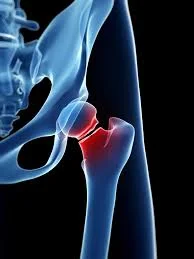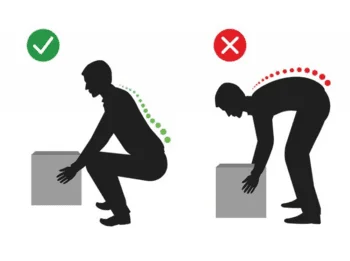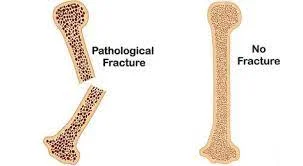Hip Fractures
Table of Contents
Introduction
A hip fracture is a break in your hip joint’s thighbone (femur).
The joints are locations where two or more bones meet. The hip joint, which connects your thighbone to your pelvic bone, is a “ball and socket” joint. The head of the thighbone is the hollow part of the hip joint. The socket is a cup-like structure located in your pelvic bone. This is referred to as the acetabulum. Hip fractures are serious injuries that require prompt medical attention.
The majority of hip fractures occur in people over the age of 60. Hip fractures become more common as people get older, doubling every decade after the age of 50. Caucasians and Asians are more likely than others to be affected. This is primarily due to a higher prevalence of osteoporosis. Osteoporosis (bone tissue loss) is a disease that weakens the bones.
Because women are more prone to osteoporosis than men, hip fractures are more common in women. Every year, more than 1.5 million Americans suffer fractures as a result of osteoporosis.
A bone can break in either a single or multiple places. A hip fracture is classified according to the location of the break and the type of break(s) in your bone.
Types of hip fracture
A fracture, as the term suggests, is a complete or partial break in the bone. A bone can be broken in one or more places. The location of the break and the type of bone break determine the classification of a hip fracture.
The most typical kinds of hip fractures are below:
Femoral neck fracture
A femoral neck fracture arises between one and two inches from the hip joint. These fractures are common in older people and may be caused by osteoporosis. Because the break usually cuts off the blood supply to the head of the femur, which forms the hip joint, this type of fracture can lead to complications.
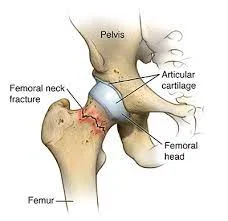
Intertrochanteric hip fracture
This type of fracture occurs three to four inches away from the hip joint. This type of fracture does not disrupt the bone’s blood supply and may be easier to repair.
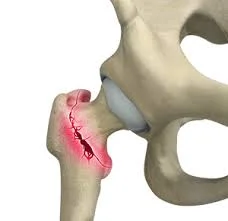
Around 90% of hip fractures fall into one of these two categories in roughly equal numbers. Another type of fracture, known as a stress fracture of the hip, may be more difficult to detect. This is a femoral hairline crack that may or may not involve the entire bone. A stress fracture can be caused by overuse and repetitive motion. This injury’s symptoms may be similar to those of tendonitis or muscle strain.
Causes of hip fractures
The majority of hip fractures occur as a result of low-energy falls in elderly patients with weakened or osteoporotic bone. In these patients, even minor twisting or tripping injuries can result in a fracture.
In some cases, the bone is so weak that the fracture occurs on its own while walking or standing. In this case, it is frequently stated that “the break occurs before the fall.” Spontaneous fractures are most common in the femoral neck.
Stress fractures or fractures caused by repeated impact are also possible in the femoral neck. Long-distance runners, particularly military recruits in basic training, are prone to these fractures. Stress fractures in the subtrochanteric region of the hip are usually caused by long-term use of certain osteoporosis medications.
Other factors that increase your chances of breaking your hip are:
- Being born with a female gender.
- Your family history, such as being thin or tall, or having family members who suffered fractures later in life.
- You are not getting enough calcium and vitamin D, which are essential for strong bones.
- Being inactive. Walking, for example, is a weight-bearing exercise that helps keep bones strong.
- The smoking history.
- Medical conditions that cause dizziness or balance problems, as well as conditions like arthritis, can interfere with steady and safe movement.
- Taking certain medications, such as long-term steroid treatments for asthma or COPD.
Symptoms of hip fracture
- Lack of ability for one to stand or walk adhering to a fall
- Hip or groin pain that is excruciating
- Pain in your hips or your knees
- Inability to bear weight on the leg on the injured hip’s side
- Swelling and bruising
- Turning the leg outward on the side of the injured hip
- Back pain in the lower back
- Impaired ability to stand or walk
- Your foot protruded at an unusual angle, making your leg appear shorter.
Diagnosis
Physical Examination
A patient with a hip fracture is usually taken by ambulance to a hospital emergency room.
You will be examined in the hospital by either an emergency room physician or an orthopaedic surgeon. They will take a history of your injury and examine you to ensure that you have no other injuries. The sensation, movement, and circulation in your lower leg will also be evaluated by the doctor.
The injured leg is frequently shorter than the opposite leg and twisted or rotated, either internally or externally.
There may be a bruise on the outside of your hip or thigh wherever you fell, and all movement will be limited and painful.
A small percentage of hip fractures may be less painful at first. These are typically nondisplaced femoral neck fractures. In this case, you may prefer to visit a doctor’s office rather than an emergency room. Even if your leg is painful, you may be able to move it and bear weight with this type of fracture.
Imaging studies
Imaging studies will assist in confirming the diagnosis and providing additional information about the fracture.
X-rays. X-rays revealed images of dense structures like bone. An X-ray can be used to diagnose the majority of hip fractures.
Scanners for magnetic resonance imaging (MRI). An MRI scan provides detailed images of both soft tissue and bone structures. Because it is so sensitive, it can sometimes detect a small or incomplete fracture that an X-ray cannot see.
CT scans are computerized tomography (CT) scans. A CT scan of your hip will provide a detailed cross-sectional image. A CT scan may be ordered by your doctor to learn more about your fracture.
Treatment of hip fracture
The treatment for a hip fracture is determined by your age, overall health, and the type of injury. The majority of hip fractures necessitate surgery within a day or two of the injury. However, some people are not in good enough health to undergo surgery due to age or other factors.
Your provider will advise you on the best course of action, which may include:
Surgery
The type of surgery is generally determined by the location and severity of the fracture, whether the broken bones are misaligned (displaced), and your age and underlying health conditions. Among the options are:
Internal repair using screws
To hold the bone together while it heals, metal screws are inserted into it. Screws are occasionally attached to a metal plate that runs down the thighbone (femur).
Hip replacement surgery
Artificial parts (prostheses) are used to replace the upper femur and the pelvic bone socket. In otherwise healthy adults who live independently, studies show that total hip replacement is more cost-effective and associated with better long-term outcomes.
Partially replaced hip. In certain cases, the hip socket does not need to be replaced. Adults with other health problems or who are unable to live independently may benefit from partial hip replacement.
Options for repair
Metal screws, plates, and rods can be used to repair a hip fracture. Artificial hip joint replacements (prostheses) may be required in some cases.
If the blood supply to the ball part of the hip joint was damaged during the fracture, surgeons may recommend a full or partial hip replacement. Because of this type of injury, which is most common in older people with femoral neck fractures, the bone is less likely to heal properly.
Physical therapy (PT)
Your PT will design a PT programme to help you regain movement, flexibility, and strength. Special exercises after hip replacement surgery can significantly improve your range of motion if you have had a hip replacement.
Medications
OTC and prescription pain relievers can help you manage pain and inflammation. If you had hip fracture surgery, you may have been given antibiotics to reduce the risk of infection.
Rehabilitation of hip fractures
Many patients are discharged home after hip fracture surgery, but some will require short-term rehabilitation in a rehabilitation facility. These patients are usually elderly or have no carers at home.
You will need to stay in a rehabilitation facility until you can walk independently and manage your daily activities.
If you return home immediately, you will receive in-home physical therapy until you are strong enough to attend therapy at an outside facility.
During the postoperative period, your doctor will oversee your care. They will examine the wound, recommend physical therapy, and take X-rays to monitor the healing process.
If you have had an internal fixation procedure, you may be unable to bear full weight for several weeks. If you have had a hip replacement, you should be able to bear full weight right away.
Complications of hip fractures
A hip fracture can lead to serious complications. Blood clots can form in the veins, most commonly in the legs. A clot can travel to a blood vessel in your lung if it breaks off. A pulmonary embolism is a type of blockage that can be fatal.
Other issues that may arise include:
- Pneumonia
- Muscle atrophy (muscle tissue wasting)
- Infection in the postoperative period
- Your bone’s nonunion or improper union
- Mental decline in elderly patients following surgery
- Bedsores caused by lying in the same position for long periods with little movement
In some fractures, blood cannot circulate properly to the head of the thigh bone. As a result, the blood supply to this area is cut off. This is referred to as femoral avascular necrosis. This complication is possible depending on the fracture type and the anatomy of your blood supply to the thigh bone’s head. Femoral neck fractures are more likely to cause this.
After a hip fracture, most people spend 1 to 2 weeks in the hospital. The recovery period could be lengthy, requiring admission to a rehabilitation facility. If you were previously able to live independently, you would most likely require the assistance of home carers or family members or the services of a long-term care facility. Hip fractures can cause loss of independence, a decrease in quality of life, and depression. That is especially valid for elderly people.
Prevention of hip fractures
Taking enough calcium every day is one of the preventive measures.
If you are a woman going through menopause, you should think about getting a bone density test. This test determines the mineral content of your bones as well as their thickness. This measurement may indicate a loss of bone mass. This is a condition in which your bones become more brittle and easily break or fracture. A bone density test is primarily used to diagnose osteoporosis and predict fracture risk.
When menopause begins, women produce less oestrogen. Most people are unaware they have osteoporosis until they suffer a fracture.
Regular weight-bearing exercise, such as walking, jogging, or hiking, is another way to help prevent hip fractures. Tai chi and other exercise programmes promote strength and balance.
Other precautions could include:
- Taking medications as directed by your doctor to prevent bone loss
- Consuming vitamin D and calcium-rich foods such as milk, cottage cheese, yoghurt, sardines, and broccoli
- Quitting smoking
- Avoiding excessive alcohol consumption
- To prevent falls, keep objects such as electrical cords off the stairs and floors.
- Installing grab bars in the tub and using slip-resistant rugs next to it
- Changing the location of night lights from the bedroom to the bathroom
- To keep rugs in place, use rug pads or nonskid backing.
- Standing on unstable furniture or step ladders is not permitted.
- Seeing an ophthalmologist once a year to have your vision checked and your vision loss treated
Summary
Hip fractures are serious injuries involving a break in the hip joint’s thighbone (femur). Most occur in people over 60, with the prevalence increasing as people get older. Caucasians and Asians are more likely to be affected due to a higher prevalence of osteoporosis.
Hip fractures can be classified into femoral neck and intertrochanteric hip fractures, with 90% falling into one or both categories. Stress fractures, caused by overuse and repetitive motion, may be more difficult to detect.
Causes include low-energy falls in elderly patients with weakened or osteoporotic bone, spontaneous fractures, and repeated impact. Factors such as being born with a female gender, family history, inactivity, smoking, medical conditions, and taking certain medications can increase the chances of breaking a hip.
Symptoms include pain, swelling, bruising, and difficulty standing or walking. Diagnosis involves a physical examination, imaging studies, and a doctor’s recommendation.
Hip fractures can be treated based on age, health, and injury type. The best course of action includes surgery, which can be internal repair using screws, hip replacement surgery with artificial parts, or a partially replaced hip.
Physical therapy (PT) is designed to help regain movement, flexibility, and strength. Medications, such as OTC and prescription pain relievers, may be prescribed to manage pain and inflammation.
Rehabilitation may involve short-term stays in a facility or in-home physical therapy. Postoperative care includes examination, treatment, and X-rays.
Hip fractures can lead to complications such as blood clots, pneumonia, muscle atrophy, infection, nonunion, mental decline, and bedsores.
Preventive measures include taking calcium daily, getting a bone density test, avoiding smoking, avoiding excessive alcohol consumption, preventing falls, using grab bars, and seeing an ophthalmologist annually for vision treatment.
FAQs
Caucasians and Asians are more likely than others to be affected. This is primarily due to a higher prevalence of osteoporosis. Osteoporosis (bone tissue loss) is a disease that weakens the bones. Because women are more prone to osteoporosis than men, hip fractures are more common in women.
Hip fracture risk increases with age. Because bones weaken with age (osteoporosis), the risk rises. Multiple medications, poor vision, and balance issues make older people more likely to fall, which is one of the leading causes of hip fractures.
The most common types of hip fracture are intertrochanteric and femoral neck fractures. Femoral head fractures are extremely uncommon and usually result from a high-velocity event.
If you have a hip joint problem, you may experience pain in the groyne, down the front of the leg, and in the knee. Pain that is referred to as radiated pain develops when knee pain is the only symptom of a hip problem, and it is quite common.
Hip repair surgery is referred to as internal fixation or “hip pinning.” Metal screws, rods, or plates are used by the doctor to hold the bone together while it heals. If the bones can be properly aligned, this surgery is usually chosen. Hip replacement surgery entails replacing a portion or the entire joint with artificial components.
References:
- Hip fracture – Diagnosis & treatment – Mayo Clinic. (2022, May 5). Mayo Clinic. https://www.mayoclinic.org/diseases-conditions/hip-fracture/diagnosis-treatment/drc-20373472
- Hip fracture – Symptoms & causes – Mayo Clinic. (2022, May 5). Mayo Clinic. https://www.mayoclinic.org/diseases-conditions/hip-fracture/symptoms-causes/syc-20373468
- Hip Fractures – OrthoInfo – AAOS. (n.d.). https://orthoinfo.aaos.org/en/diseases–conditions/hip-fractures/
- Articles. (n.d.). https://www.cedars-sinai.org/health-library/diseases-and-conditions/h/hip-fracture.html
- Professional, C. C. M. (n.d.). Hip Fracture. Cleveland Clinic. https://my.clevelandclinic.org/health/diseases/17101-hip-fracture
- Types. (2017, September 11). Stanford Health Care. https://stanfordhealthcare.org/medical-conditions/bones-joints-and-muscles/hip-fracture/types.html

